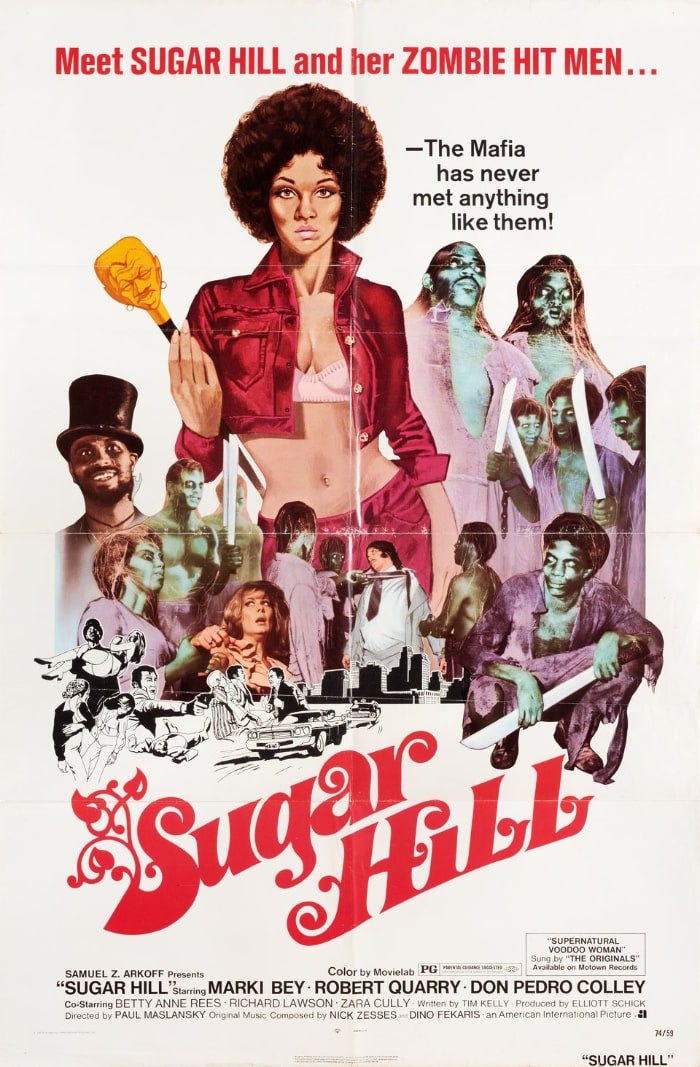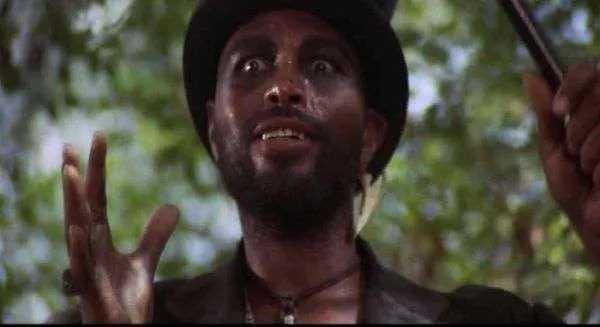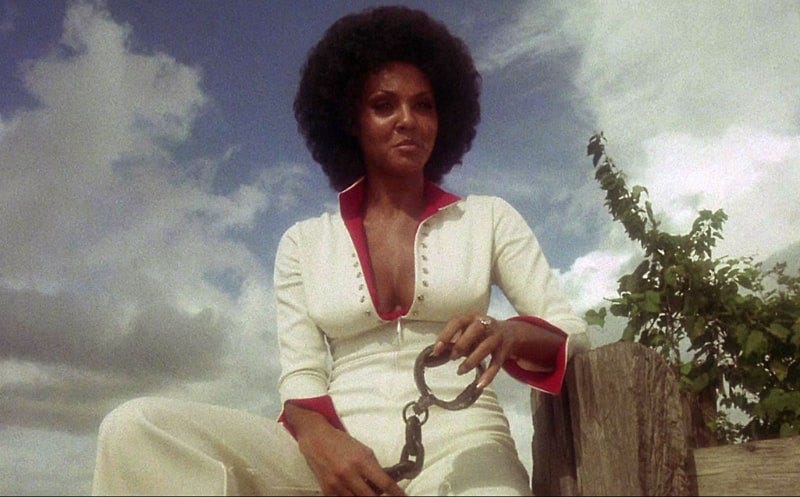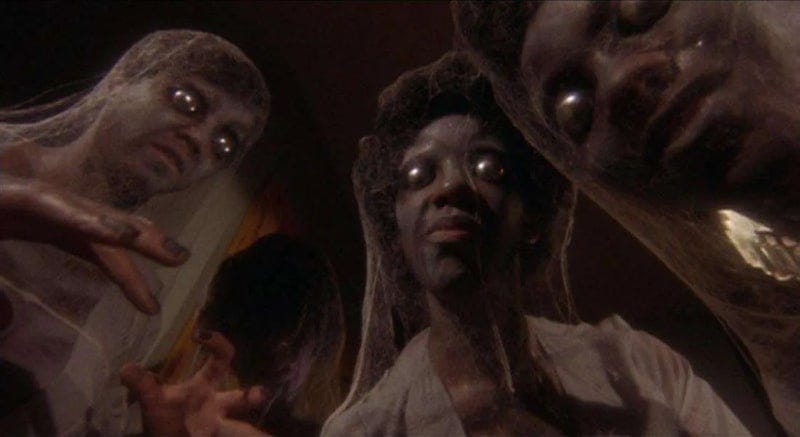Blaxploitation Education: Sugar Hill
If you have to use voodoo in a Blaxploitation movie, might as well turn it into a weapon of revenge.
Sugar Hill
Written by Tim Kelly
Directed by Paul Maslansky
1974
I’ve complained before about the use of voodoo in movies as a sort of vague concept of old-world supernatural mysticism that Black people have access to. All the stuff about voodoo dolls and resurrecting the dead to serve as zombie minions is almost entirely invented by white people, and it’s one of those dumb racist things that still shows up in movies from time to time, long after people should have known better. But I suppose if somebody had to make a Blaxploitation movie that uses those stereotypical voodoo elements, they might as well have had fun with it and turned it into a tool of Black vengeance.
That’s what we get with Sugar Hill, a cheap exploitation movie that has fun with these ideas, treating them less as an element of horror and more as a great way to serve comeuppance on bad guys. The movie opens with what appears to be a voodoo ritual, set to the movie’s theme song, “Supernatural Voodoo Woman,” by The Originals, which is pretty enjoyably catchy. We see a shaman handling snakes and serving goblets of chicken blood to the participants, and other people gyrate around in a manner that seems suspiciously choreographed. But then we pull back and see that this is a dance routine being performed in a Louisiana nightclub called Club Haiti, showing that the movie is self-aware about the ridiculousness of what it’s depicting.
The owner of the club is a guy named Langston (Larry D. Johnson), and his girlfriend, Diana “Sugar” Hill (Marki Bey), congratulates him on the ongoing success of his business. It won’t last long though, because he gets confronted by a group of tough guys who get mad that he won’t agree to sell the club to their boss. After he tells them off, they threaten him and leave, and then they follow that up by jumping him in the parking lot and beating him to death. This leaves Sugar devastated by grief, but also full of rage and ready to get back at the guys who wronged her.
To do so, she visits the local voodoo priestess, Mama Maitresse (Zara Cully, who would later play Sherman Helmsley’s mother on the TV show The Jeffersons), and begs for her help. Mama Maitresse is initially reluctant, since she claims to have given up voodoo (even though she spends all her time alone in a cobweb-filled mansion), but she relents pretty quickly, taking Sugar out to the swamp to summon Baron Samedi, a notorious folkloric figure who sits at the crossroads of life and death, and who viewers might recognize as one of the villains in the James Bond movie Live and Let Die.
Here, Baron Samedi is something of a trickster figure who controls an army of resurrected zombies, and while he supposedly strikes a hard bargain for those who want his services, he acquiesces to Sugar’s requests pretty quickly, and he even takes part in her various schemes. He’s played by Don Pedro Colley, who previously appeared in Black Caesar and The Legend of N***** Charley, and it’s a shame he didn’t show up in more Blaxploitation movies, because he is a delight. He hams it up mightily, cackling with sinister laughter and sporting a crazed grin as he gives ominous speeches about his terrible powers. Later on, when he goes undercover, playing roles like a taxi driver or gardener, he takes on an almost minstrel-like attitude of servitude toward the white people being targeted before he gets the chance to put on his top hat, grin at their stupidity, and sic his zombies on them.
Sugar, for her part, also slips into an over-the-top role as she and her zombie crew go after the guys who killed her boyfriend and the crime boss they’re working for, Morgan (Robert Quarry). When she confronts them, she switches from a wig that features a relaxed, Farrah Fawcett style to an afro, and her voodoo vengeance outfit is a white jumpsuit with red trim and the collar and cuffs, unbuttoned to show off her cleavage. She gets to gloat and spit imperious, smirking one-liners, like when she feeds one of the henchmen to some pigs and says, “I hope they’re into white trash.” It makes for a pretty fun switch from her “civilian” identity of a mild-mannered woman who is grieving for her boyfriend to a more powerful and truthful role as someone on a mission of righteous vengeance.
And, well, that’s about all this movie consists of: Sugar and Samedi picking off the bad guys one by one as they work their way up to the boss. They typically lure the thugs to some remote location before the zombies step out of the shadows and attack. These zombies are kind of goofy looking, sporting metal orbs for eyes that are probably supposed to look like they’re empty and gleaming with magical light but actually seem like the actors have just had ping pong balls with metallic paint glued onto their faces. Also, they’re always covered in cobwebs, which sort of makes sense when they first dragged themselves out of their graves, but by the end of the movie, you start wondering if they took some extra time to get into costume before they were unleashed on their unsuspecting victims.
As the movie goes on, it’s fun to see Morgan and his men get increasingly scared about what’s going to happen to them. Morgan’s girlfriend Celeste (Betty Anne Rees, who didn’t show up in any other Blaxploitation movies but did appear in a 1972 roller derby movie called The Unholy Rollers) especially takes umbrage at the way he acts friendly toward Sugar, and in one satisfying scene, she shows up at the nightclub to confront her. When she calls Sugar “uppity,” the latter responds by saying, “My dear, talking to you means I look nowhere but down!” Then, when they get into a fight, Sugar beats her pretty badly and sends her running away.
That’s the real pleasure of this movie: seeing white criminals (and one Black one named Fabulous, played by Charles Robinson, who later starred on the TV show Night Court; he meets his end at a massage parlor when Sugar switches out his regular masseuse for some female zombies) think they can get the upper hand over Black people before being thoroughly humiliated and dispatched. The movie takes the voodoo stereotype and, rather than treating it as something horrific that serves as a haunting legacy of slavery and oppression, turns it into a weapon to be used against people who look more and more pathetic as they cling to their belief in their own superiority. In that way, it fits right alongside other Blaxploitation movies. I wouldn’t call this one of the best of the genre, but man, it’s sure satisfying to see racists get killed gruesomely. No matter how many of these movies I watch, that’s something I’ll never get tired of.
Blaxploitation Education index:
UpTight
Cotton Comes to Harlem
Watermelon Man
The Big Doll House
Shaft
Sweet Sweetback’s Baadasssss Song
Super Fly
Buck and the Preacher
Blacula
Cool Breeze
Melinda
Slaughter
Hammer
Trouble Man
Hit Man
Black Gunn
Bone
Top of the Heap
Across 110th Street
The Legend of N***** Charley
Don’t Play Us Cheap
Shaft’s Big Score!
Non-Blaxploitation: Sounder and Lady Sings the Blues
Trick Baby
The Harder They Come
Black Mama, White Mama
Black Caesar
The Mack
Book of Numbers
Charley One-Eye
Ganja & Hess
Savage!
Coffy
Shaft in Africa
Super Fly T.N.T.
Scream Blacula Scream
Cleopatra Jones
Terminal Island
Gordon’s War
Slaughter’s Big Rip-Off!
Detroit 9000
Hit!
The Spook Who Sat by the Door
The Slams
Five on the Black Hand Side
The Black 6
Hell Up in Harlem
I Escaped From Devil’s Island
Blackenstein
The Bad Bunch
That Man Bolt
Willie Dynamite
The Arena
Black Belt Jones








"When she calls Sugar “uppity,” the latter responds by saying, “My dear, talking to you means I look nowhere but down!" Fabulous put-down.